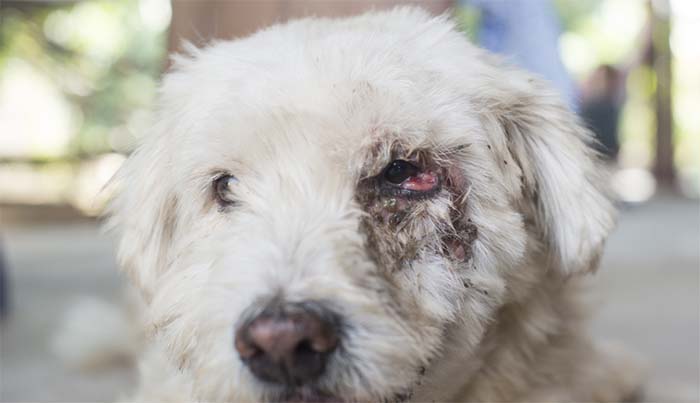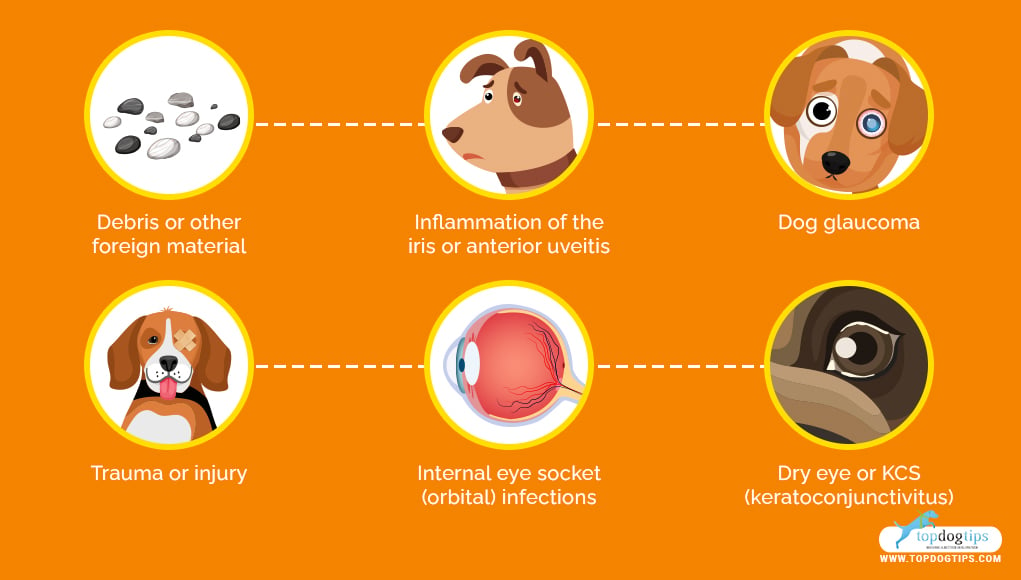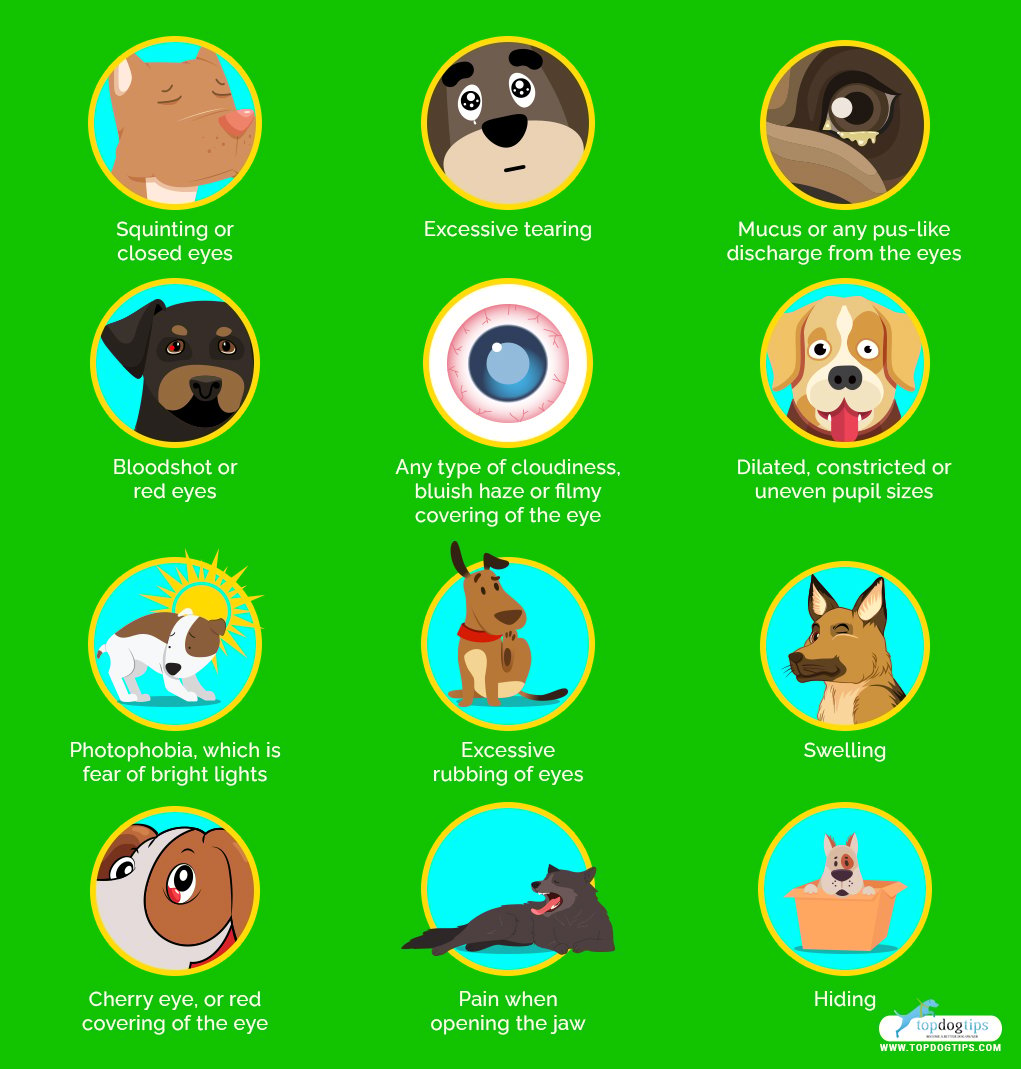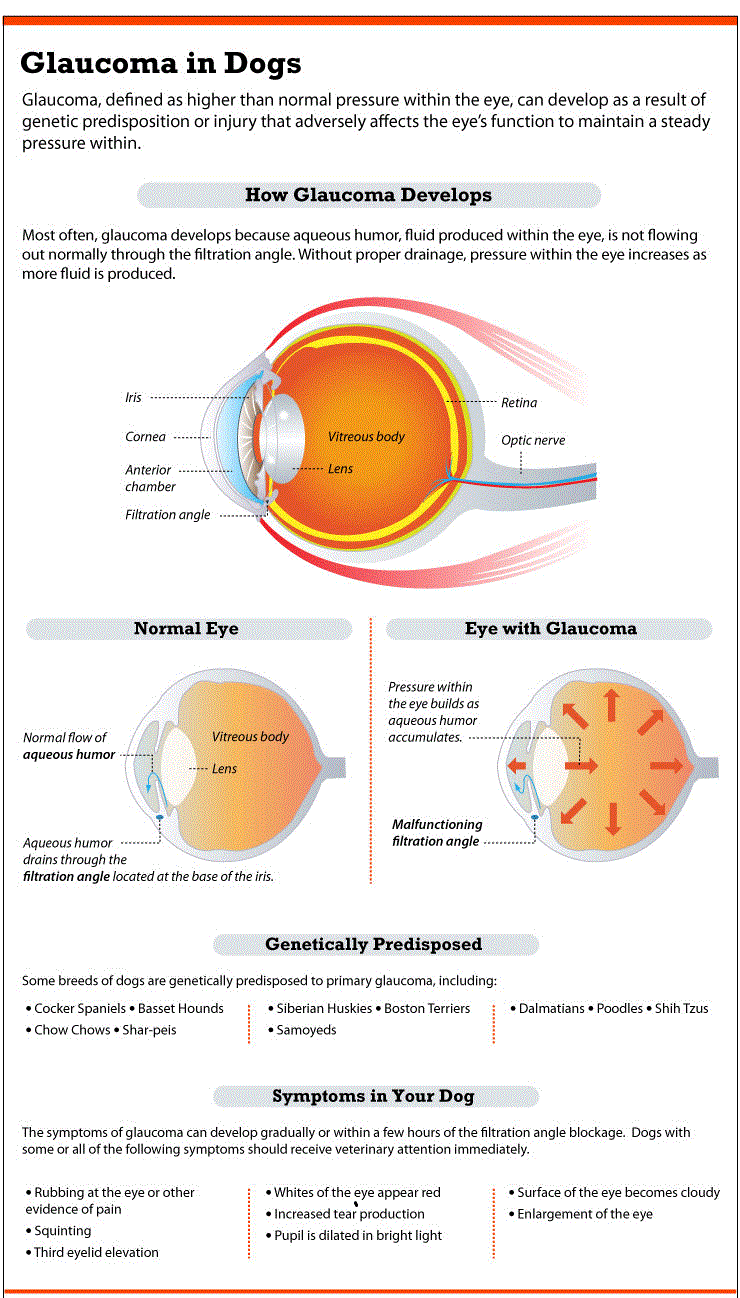
Table of Contents
My dog won't open his eyes. What should I do?
You’ve noticed your dog looking at you a little funny the last few days.
It was almost like a cute winking in one eye or both.
Today though, you are sure of it – your dog is genuinely squinting, and it is in both eyes.
What does it mean?
 Anytime your dog is having a problem with its eyes, you should take it seriously and consult your vet.
Anytime your dog is having a problem with its eyes, you should take it seriously and consult your vet.
There are many potential eye problems in dogs that may or may not be serious.
Your vet can help determine the underlying cause, whether benign in nature or something severe, and set your dog on the right treatment program.
In most cases, when pet owners run into the vet's office saying their dog won't open his eyes, dog eye pain is the reason.
There's something that causes your pooch pain whenever his eyes are open.
Thus he chooses to keep them closed to avoid eye pain.
When a dog is suffering from eye pain, its reaction is to squint and keep its eyes closed.
Sometimes your dog may show signs of behavioral distress.
Your dog could hide it by sleeping more or can show decreased appetite, aggression, and hiding behaviors.
You must consider several things if your dog won't open his eyes, so here's everything you must know.
SUGGESTED READ: 12 Dog Eye Infection Treatments and Preventatives
My Dog Won't Open His Eyes. What Should I Do?
Canine Eye Pain
Canine eye pain or discomfort can occur from either external or internal irritation of the eye (Dr. Mcnabb, 2015).
There can be other signs of eye pain in dogs, including pawing at the eyes, avoidance of hard foods, and a refusal to open his mouth too fully.
Dogs can’t tell you what they are feeling, so it may not always be easy to know that your dog’s discomfort is due to eye pain.
Many different causes could be behind your dog’s eye pain, including eye infections, bacteria, or injury.
The first thing most owners do is try a few basic at-home remedies like saline to flush the eyes; after that, if your dog doesn't open his eyes still, then you have to seek the help of a professional.
In most cases, when you find yourself saying your dog won't open his eyes, the likely cause is that your pooch is suffering from eye pain that needs to be dealt with.
Your dog’s eyes' reaction to pain is due to a high concentration of pain fibers or nerves within the cornea and conjunctiva.
The highest distribution of these nerve fibers is located near the surface.
A corneal ulcer or scratch can be extremely painful and cause a reflexive spasm of the iris inside the dog's eye.
The severe pain that these types of dog eye nerve reactions can cause your dog will result in your dog squinting or holding his eyes shut completely as a way to cope or try to deal with the pain.


Once you realize that flushing with saline or dog eye drops is not a solution and that there is no debris in your pet's eye to cause discomfort, you need to seek medical attention.
Do it immediately to determine what could be any one of several causes of eye pain.
Below is what you should consider.

Common Causes of Eye Pain
There are many different causes of eye pain that your veterinarian will go over with you when you arrive.
Your vet will use special equipment to look into your dog’s eyes to see things that are not visible to the naked eye.
Your veterinarian is looking for signs that point to common causes of eye pain.
Some of these causes of eye pain in dogs that veterinarians find more frequently, according to the Merck Vet Manual, are:
- Debris or other foreign material on the surface of the eye.
- Inflammation of the iris or anterior uveitis may cause dog eye pain. Your vet will have to determine the direct cause of the uveitis to treat it.
- Dog glaucoma, which causes elevated pressure on the inside of the eye, can feel like a pain sensation to a dog. Their instinct can be to hold their eyes closed.
- Trauma, or some injury to the eye tissue or the eyelids, may be causing pain.
- Internal eye socket (orbital) infections are excruciating and will often cause signs of mouth-related issues, such as refusal to open his jaw.
- Dry eye, or KCS (keratoconjunctivitis), can cause dogs to have a painful gritty, dry sensation on the surface of the eye. This can lead to keeping the eyes closed.

Your veterinarian will go over the common causes of eye pain while examining your dog.
Generally, it will be one of these conditions that are causing your dog’s eye pain, and your vet can start a treatment plan right away.
Your vet can use a special ophthalmic medication, atropine, to immediately reduce the symptoms of pain for your dog.
Furthermore, on some occasions, your dog may be keeping his eyes shut because of the dog eye care products you've used to deal with this, like dog eye boogers (tear stains).
Some of these can be overdone, and others are not always completely safe, even if they're effective.
Angel Eyes for Dogs, for example, is a controversial product.

Symptoms of Dog Eye Pain and Issues
When your dog is having eye pain, he's likely to demonstrate this in several ways.
If you say my dog won't open his eyes, it's the first sign of something wrong.
But other signs can be physical, while others are behavioral.
Some dog eye pain symptoms may be obvious to you, and others you may not even notice.
While there are several dog eye care products, you can try to flush out your pet's eyes to ensure there's no debris.
If your dog still won't open his eyes after that, a vet visit is a must.
Your veterinarian will discuss the number of symptoms that you should be watching for as you start treatment for your dog's eyes.
These symptoms are also the most common signs of dog eye pain which you should seek veterinarian assistance right away:
- Squinting or closed eyes
- Excessive tearing
- Mucus or any pus-like discharge from the eyes
- Bloodshot or red eyes
- Any cloudiness, bluish haze, or filmy covering of the eye
- Dilated, constricted, or uneven pupil sizes
- Photophobia, which is fear of bright lights
- Excessive rubbing of eyes
- Swelling
- Cherry eye, or red covering of the eye
- Pain when opening the jaw
- Hiding
Whenever your dog is showing these types of dog eye pain symptoms, it is time to call the veterinarian.
It is important because even if you do not understand your dog’s fear of bright lights or hiding behavior, know that not all eye diseases cause direct eye pain sensations.
Your dog may be having other eye difficulties that it is having trouble expressing, such as a type of dog eye allergy.
The only way to know is through a complete and thorough examination at the vet's office.
Eyes are a susceptible issue, so this must not be delayed.
If you find yourself looking up information online on my dog won't open his eyes, and you've already tried washing them, then it's time to call your vet.
Ignoring it may not only impair your dog’s sight but its ability to communicate.
Complete Examination of Dog Eye Pain
When your dog gets to the veterinarian or specialist, the first thing is to go over your dog’s complete medical history and do a thorough physical examination.
Your vet will then begin a complete ophthalmic examination.
The dog's eye exam can only be done after the vet uses a topical pain reliever to stop the squinting.
Your vet will do several tests, including a Schirmer test, a fluorescein stain of the cornea, and tonometry.
Using magnification, an examination of the eyelids and the surface of the dog's eyes is completed.

From there, your vet can do additional eye examinations as needed, such as an ocular ultrasound.
Complete blood counts are also taken to see if there are any other underlying conditions.
Because eye pain in dogs can be a symptom of a severe health problem, all possible conditions need to be ruled out through a thorough examination and diagnosis.
Corneal Ulcers in Dogs
Corneal ulcers are one of the most common causes of eye pain in dogs (NHAH, 2014).
A corneal ulcer can be a severe condition and is often caused by trauma.
They are also tough to treat, and some veterinary sources say that it may even be impossible.
Dogs rubbing their eyes on the carpet or getting a cat scratch can cause an ulcer.
Veterinarians use the fluorescein stain to see the layers of the epithelium to see if there is an abrasion or ulcer in the dog's eye and how deep it has formed.
Corneal ulcers in dogs are a severe condition that requires veterinary attention immediately.
It's painful for the dog, and your vet can help get treatment started immediately.
Glaucoma in Dogs
Glaucoma is a common condition that results in eye pain in dogs.
This condition causes pressure to be placed on the dog's eye, causing inner eye fluid drainage blockages.
Glaucoma can become a chronic condition.
It can cause eye pain and, if left untreated, will eventually lead to blindness.
However, regardless of treatment, over 40% of all dogs with glaucoma will go blind within a year, even if they get treatment.

My Dog Won't Open His Eyes: FAQs
Why is my dog squinting both eyes all of a sudden?
Dogs' squinting eyes could be the result of a more serious problem, including a foreign object in the eye, corneal ulcers, glaucoma infection, trauma, or insufficient tear production.
Take Fido to the vet for a checkup if you think he could have a corneal ulcer.
The ulcer is likely to be treated with topical antibiotics, and your vet may also suggest using certain eye solutions to speed up the healing process.
What if my 3-week-old puppy hasn't opened his eyes?
Puppies' eyes aren't fully grown when they are born, which is why they are closed at birth.
The eyes continue to develop over the following two weeks, so your dog's eyes have to be shielded from environmental factors that can harm them.
Why is my dog's eye swollen shut?
It can develop as a result of a secondary irritant like soap or smoke or an invasive foreign substance like dust, hair, or grass.
Infections in the eyes can also be brought on by viruses such as canine influenza, herpes, hepatitis, and distemper.
Dogs' eyes might swell up due to parasites and fungi as well.
My Dog Won't Open His Eyes: Before You Go
When you run into the vet's office saying your dog won't open his eyes, your veterinarian will prescribe a treatment plan for your pooch.
You must follow the plan accordingly.
It could include things like steroid eye drops, antibiotics, or even surgery.
It would help if you were sure to follow through with your veterinarian’s orders.
Your dog’s eyes will last their lifetime and are its way of getting through life, protecting itself and you, and expressing its emotions and feelings.
Your best friend is committed to you with no strings attached.
Now it’s up to you to follow through and help your dog get through this medical emergency.
References and further reading:
- AnimalPlanet. (2017). Dog Eye Disorders.
- Dr. Mcnabb, N. (2015, August 6). Ocular (Eye) Pain and Squinting in Dogs.
- NHAH. (2014). My Dog is Squinting. Corneal Ulcers in Dogs. Retrieved from Newport Harbor Animal Hospital: https://www.newportharborvets.com/services/dogs/blog/my-dog-is-squinting
- PetMD. (2017). Glaucoma in Dogs.













